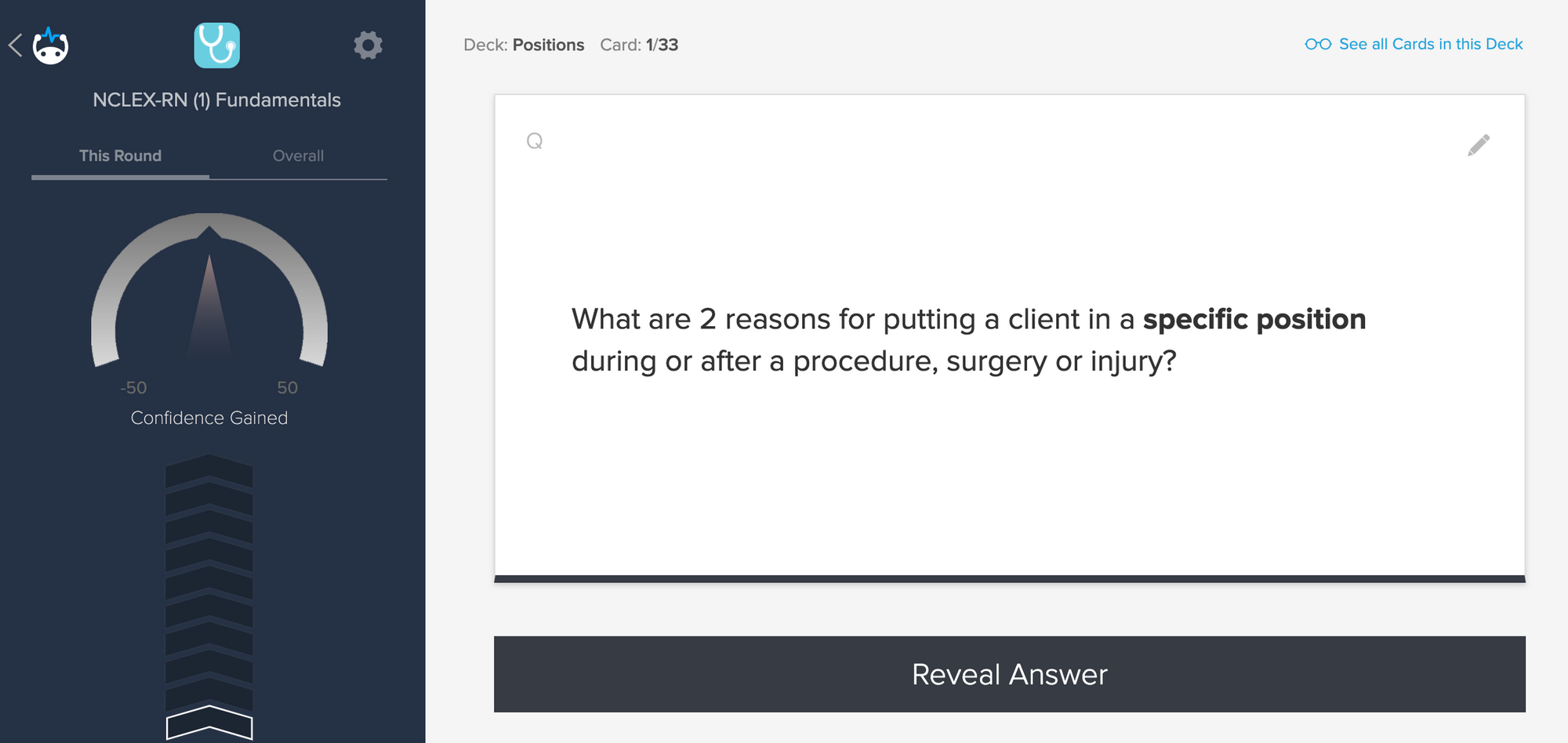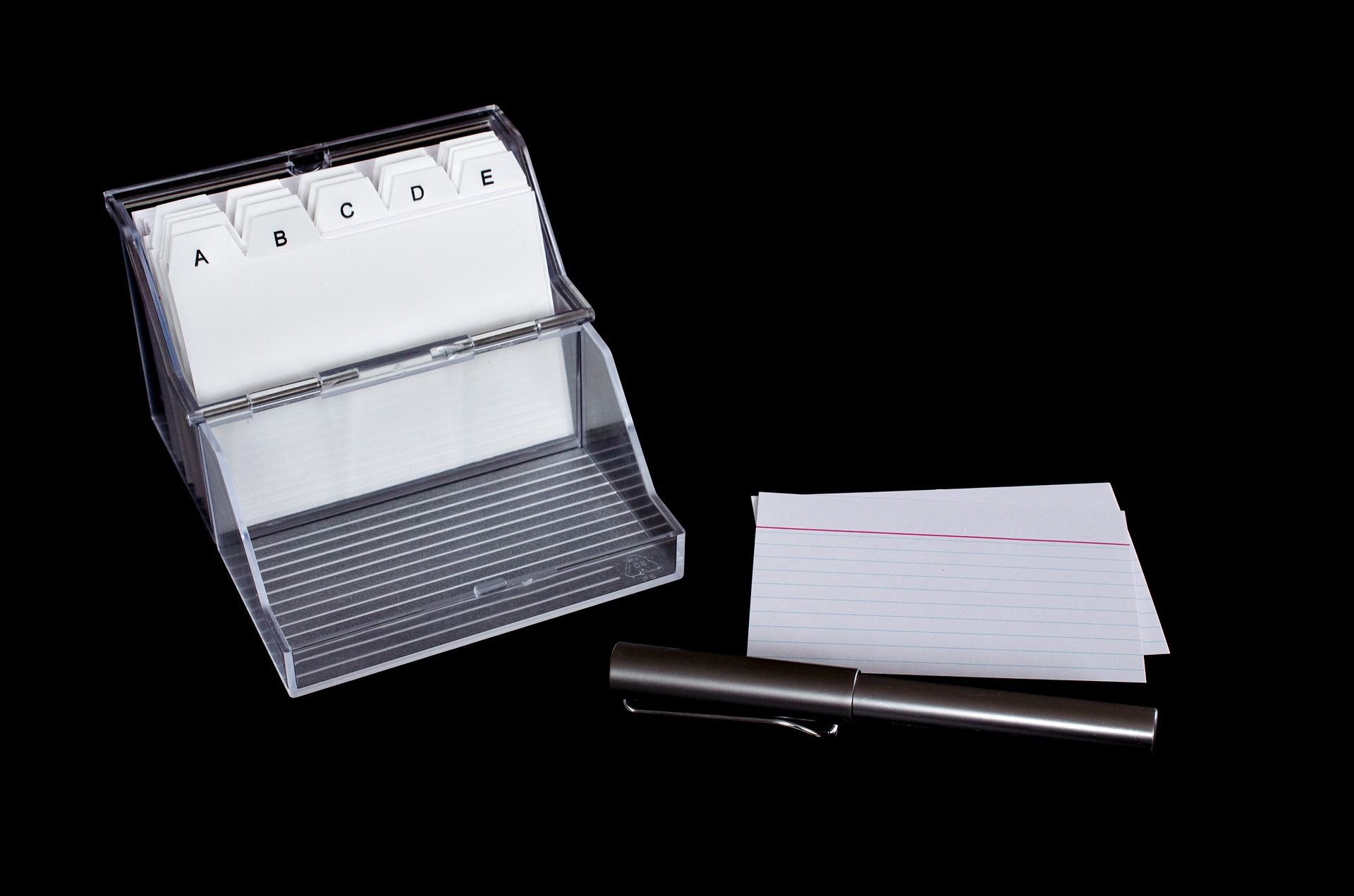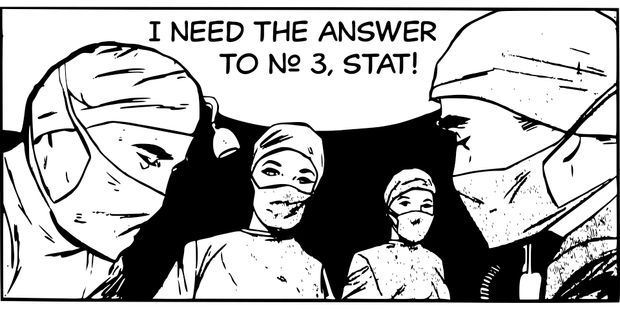There are millions of NCLEX practice questions out there in the wild west of the internet. However, when it comes to preparing for the NCLEX, not all practice questions are created equal.
In this guide, you’ll learn:
- The NCLEX test and question formats
- Where to find the best NCLEX practice questions
- The most effective way to use practice questions in your study prep
- Two complete examples of how to answer NCLEX questions correctly
We know this stuff because we've spent the past few years working with our nursing education partner, Justine Buick, to create the world's most effective NCLEX RN or NCLEX PN flashcards app that helps you internalize the concepts needed to nail the NCLEX. Now let's take a look at practicing the exam questions themselves.
NCLEX test and question formats
All nursing students know that studying for the NCLEX is a big undertaking. There’s an enormous range of review books, literally thousands of facts. To conquer the NCLEX, you need to condense all this information into your head, ready to use on test day.
[We also know how overwhelming it is to study for the NCLEX. Here's how to banish your stress!]
One of the best ways to check your exam readiness is to do NCLEX-style practice questions. They’re useful not only to gauge where your weak points are but also to familiarize yourself with the format of the real test.
The NCLEX test format
Multiple choice is the most frequent question format on the NCLEX. However, there are also several other types of question formats, including:
- Select All That Apply (SATA) (30-35% of most tests)
- Drag-and-Drop
- HotSpot questions
- Fill in the blank
[Brainscape created a guide on how to do 'Select All That Apply' NCLEX questions. that's definitely worth your time to read!]
You can find a good overview of the NCLEX overall format in the NCSBN Test Plan. This is revised every 3 years and will give you a breakdown of the content categories you’ll be tested on, and what percentage of the test each category accounts for.
(NCSBN is always evolving this test; in fact, in 2023, they made some big changes with the introduction of Unfolding Case Scenarios. Make sure you read all about that here: What to expect from Next Generation NCLEX.)
With all the NCLEX questions, you only progress to the next question once you’ve answered the current one, meaning you can’t skip questions you’re unsure about.
How computerized NCLEX testing works

With the introduction of Next Gen NCLEX questions, the minimum length of the exam will be 85 questions (70 scored and 15 unscored) and the maximum 150 questions (135 scored and 15 unscored).
The number of questions you’ll need to answer is variable because the NCLEX uses computerized adaptive testing (CAT). The testing software decides at what level of difficulty you’ll be tested.
How does this work?
As you’re served questions, computer algorithms work hard behind the scenes, posing you harder and harder questions. Then, when you get one wrong, the computer will back off from giving you such a hard time and pose you an easier question, gradually increasing the difficulty until you make another mistake.
This is why the number of questions you get is dependent on how well you perform. You’ll continue to receive questions for each topic until the computer has determined that your knowledge is above its passing level (or not).
How long will your NCLEX exam take?
The length of the NCLEX exam can vary. However, you have a maximum of 5 hours to take the test. The person sitting next to you may finish quickly, or may still be there an hour after you leave. This is because the computer is creating an individual exam for each student, on the fly.
However, there are certain limits to how short or how long your test will be. For example, if your NCLEX RN exam ends after 75 questions, you’ve either aced it or failed. (This causes a fair amount of anxiety among students).
If you’re getting some questions wrong, and some right, you may have to answer up to 150 questions before your exam ends. And no matter how many questions you’ve answered, your NCLEX RN test will end after five hours. For most students, the NCLEX is more of a long distance race than a sprint, and this guide will help you train for it!
Where to find the best practice test questions

At the start of this NCLEX guide, we mentioned that not all practice test questions are created equal. There are no ‘official’ test questions and no policing of what’s out there. The quality of questions you’ll find with a Google search is (highly) variable.
It’s like the hospital ER over Mardi Gras. You just never know what you’re going to get! So if you’re trying to answer NCLEX practice questions that are confusing or ambiguous (or downright wrong), chances are you’re not using a good source. And for the record, even the best sources make a few mistakes here and there.
While the real NCLEX test questions do require you to think clearly, they’re never deceptive or misleading. Questions that feel like the examiner is trying to trick you are often just badly worded or are not representative of what you will actually be given on test day. Using poor practice questions just causes unnecessary confusion, which is why you’re better off sticking to the recommended resources below.
Psst. You should also check out this article: 'Common NCLEX mistakes and how to course-correct'. Also, get your free NCLEX study planners and exam countdown sheets to plot your path towards and remain razor focused on your study goals!
The NCLEX practice questions we recommend
The NCLEX Mastery app has good practice questions, and we like it because the questions are straightforward and easily understood. They also include a representative blend of the different question formats you’ll see in the real NCLEX. The app includes around 2,300 questions organized by topic, which helps you keep your test practice relevant to what you’re currently studying in class.
We also like the Saunders Comprehensive Review book. This is a good resource because you can first read a chapter (and review NCLEX RN flashcards in Brainscape or NCLEX PN flashcards for the same topic) before testing yourself using the questions at the end of the chapter. In addition, they supply a lot more practice questions (around 5,000) on the book’s companion website.
The most effective way to use NCLEX practice questions in your study prep
Do around 25-75 questions a day
Answering practice questions every day means you can’t leave studying until the last week before your test, and then try to cram everything into your brain in a mad dash for the finish line.
If the NCLEX were an Olympic track and field sport, it would be a medium long-distance 3,000-meter run, not a 100-meter sprint.
Brains aren’t like an infinitely extendable suitcase you can jam the entire NCLEX catalogue into over a few days. Storing things in your memory and building a knowledge base is more like creating a well-ordered library.
You take time to build good, solid shelves, and then gradually stock them with the facts that live in each section. It’s a meticulous process, but if you do it properly and with enough time, you’ll be able to retrieve facts from your memory to answer NCLEX questions without a great deal of effort.
After all, since you’re serious about nursing as a career, the information you are reviewing for the NCLEX is intended to help you save lives while you’re on the job. You’ll want to have it neatly stored in your long-term memory, ready for when you need it.

With that in mind, here’s the best structure for answering NCLEX practice questions:
- Do a little bit, every day. It’s the best way to study for the NCLEX exam efficiently. Science says so ...
- Review the relevant content first using your NCLEX RN or PN flashcards or by reading the material in your study review.
- Do 25-50 practice questions on the topic you’ve just reviewed.
- If you have time, do another 25 or so questions on topics you’ve reviewed in the past few days. This uses the principle of spaced repetition to more fully embed information in your long term memory.
Using this system, you’re keeping a consistent study schedule, which is the most effective way to study for the NCLEX. If you don’t study regularly and with frequent review of the material you previously covered, by the time the test rolls around, you very well may have forgotten a lot of this earlier material. And this could fatally wound your test scores.
The most convenient and automated way to follow this study plan is to use Brainscape NCLEX-RN flashcards or Brainscape NCLEX-PN flashcards. Brainscape’s intelligent algorithm repeats content for you at optimal intervals so you spend very little time reviewing facts you do know well, and quickly cover and master the subjects you don’t know so well. The algorithm repeats cards for you just often enough to keep them in the easily accessible parts of your memory library.

These 3,490+ smart, digital flashcards cover the most important concepts in the latest NGN test plan, as well as Saunders, Kaplan, Hurst, Lippincott, HESI, Khan Academy, and other top NCLEX review books and courses. In other words, no matter which one you’re using, we’ve got you covered!
Two sample practice questions
To finish things off, let’s look at two examples of how to do NCLEX practice questions. This will give you an idea of the critical thinking you’ll need to employ when working out the correct answer.
The first example is about blood administration. This question requires knowledge of labs, fluids, electrolytes, and gastrointestinal problems.
If you were going to answer a series of these questions, you’d first read the relevant content in your review book, or study that card deck in your Brainscape NCLEX RN flashcards series or Brainscape NCLEX PN flashcards series. Then, with a refreshed memory, you’d have a go at answering the questions below.
1. The nurse in the emergency room is caring for a client with lower gastrointestinal bleeding who has received multiple blood transfusions. Which finding would the nurse report immediately to the healthcare provider?
A. Hemoglobin of 10.2 mg/dL
B. Dark, red stool
C. Positive chvostek’s sign
D. Abdominal pain
The key point of this question is that when you report something “immediately” to the healthcare provider it needs to be because of an immediate life-threatening complication. This is the filter to use when evaluating the four possible answers.
A. Normal hemoglobin is 14-18 if male and 12-16 if female. 10.2 is low, but it’s an expected low number if the client has had bleeding. The HCP won’t be concerned about that reported level of 10.2 because they know the client is bleeding: it’s why the client had the blood transfusion.
B. The dark red stool is indicative of old blood or blood from the stomach. It’s expected and the HCP won’t be concerned again because it’s why the client is getting the transfusions.
C. Positive chvostek’s sign occurs when the facial muscles twitch when tapped. It indicates a low calcium level. This is an unexpected finding and relates to multiple blood transfusions.
A low calcium level can contribute to more severe problems such as seizures or heart dysrhythmias (although that’s not occurring yet in the question). Low calcium levels occur because the preservative in the blood can bind with RBCs. The client then excretes too much calcium causing it to drop abnormally low. The client will need calcium replacement to correct this. In this situation, the HCP should be notified immediately.
D. Abdominal pain is expected with a lower GI bleed. The HCP knows that this is an expected finding that won’t immediately harm the client.
The correct answer is C. This question is designed to test the prioritization of how urgently a patient needs medical intervention. Getting the right answer requires you to evaluate what the condition is you’re looking for: an urgent situation that will need immediate intervention.
On to question number two. This one is about anaphylaxis in a child.
2. A toddler with a history of repaired lumbar myelomeningocele is in the emergency department presenting with wheezing and a skin rash. Which question should the nurse ask the parents first?
A. “Who brought your child to the Emergency Department?”
B. “Is your child allergic to bananas or any other foods?”
C. “What have you done to treat the rash?”
D. “What medications is your child taking?”
When there is symptom data, try to interpret it. What does it mean that a toddler with repaired myelomeningocele is experiencing wheezing and a skin rash? It sounds like the toddler is having an anaphylactic reaction, but WHY?
To answer this question correctly, you’d have to know that it’s common for children with repeated myelomeningocele repairs to develop allergies to latex. This is because latex is used in many surgeries, and too much exposure to it can bring about sensitivity or an allergy to it. And it’s a possibility the child came in contact recently with something that contained latex.
With that in mind, let’s evaluate the possible answers:
A. It’s not pertinent to know who brought the child to the ED. It gives you no information about how to immediately help this child who may be going into anaphylactic shock.
B. There is a cross-sensitivity with bananas, some other foods, and latex. This is a great answer because it provides more information to figure out what the problem is so that it can be fixed.
C. Even though it’s important to know what has been done to treat the rash, it doesn’t help to determine the cause of the symptoms. Keep in mind that the nursing process is ADPIE (assess, diagnose, plan, implement, evaluate). For this situation, assess first to figure out a cause before asking about interventions.
D. Even though it is important to know what meds the child is taking, it’s not specific enough to the situation. There is a high risk of latex allergies with myelomeningocele repair surgeries. And there can also be food sensitivities with latex allergies. Some meds can cause anaphylactic reactions, but this would be the second, not the first question to ask.
So the correct answer is B. The nurse should ask about food allergies first because it is most specific to the problem in the question.
NCLEX practice questions in summary

In summary, doing NCLEX practice questions is an important part of preparing for this test, and the NCLEX Mastery App and Saunders Review are our top recommendations for good practice questions.
To make the most of these practice questions, study the relevant material beforehand using Brainscape NCLEX RN flashcards or Brainscape NCLEX PN flashcards. Then, make test practice a regular part of your study, and aim to do 25-75 practice questions per day.
Follow this system, and you’ll be in a strong position to ace the NCLEX, with a well-paced, low-stress study schedule. More importantly, the knowledge you learn will end up neatly organized in your long-term memory, ready for when you need it in your nursing career.
**NCLEX-RN® is a registered trademark of the National Council of State Boards of Nursing (NCSBN), which neither sponsors nor endorses this product.
